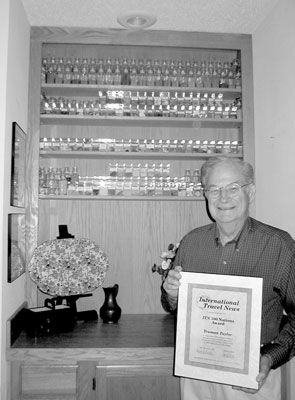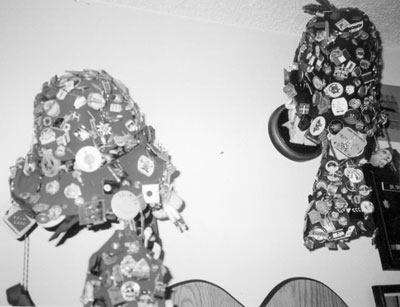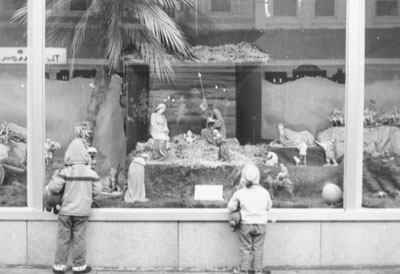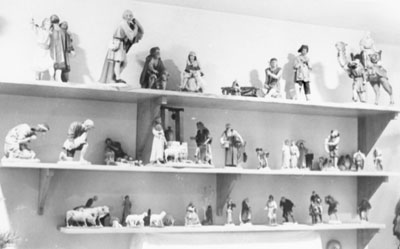Memorabilia
What do YOU collect on trips overseas? What got you started? Have you derived any special benefits or had any interesting experiences due to your searches? Do you have any tips for others on a similar quest?
Those were the questions we put to you a few months ago, and below are some of the replies. We’ll have more in next month’s issue. One interesting development — we expected that most travelers would be going after a small number of collectibles, but, except for one theme, the items named are surprisingly diverse.
If you have a collection you’d like to tell others about, write to Memorabilia, c/o ITN, 2116 28th St., Sacramento, CA 95818, or e-mail editor@intltravelnews.com (please include your surface-mail address).
Back in 1992 we decided to drive the Mississippi River from Louisana to Minnesota. We thought it would be interesting to compare the water quality at each end. We used two very small jelly jars (from gift packs) and dipped one in Venice, Louisana, and then one in Lake Itasca, Minnesota.
Since then, on all our travels, we have continued taking water samples — of oceans, seas, lakes and rivers. We now have 38, including the Arctic Ocean at Barrow, Alaska; the Great Salt Lake in Utah; McMurdo Sound, Antarctica; the Panama Canal; the Timor Sea at Darwin, Australia; Loch Lomond in Scotland, etc.
Helpful hints — ask guards for permission, and use Kleenex tissue to wrap the empty and full jars.
Bernard V. Sigg
Winter Haven, FL
I completed visiting 100 countries in January 2003. I call my collection of rock and soil samples from all 100 countries my “travel collection.”
I began collecting soil samples from all the states in the U.S. and then moved on to greater achievements by collecting them from countries. However, because it is illegal to bring soil in from other countries, I needed to change to rock samples.
Truman Taylor
The Woodlands, TX
I bring back two things from overseas trips: stones and postcards!
One wall in our home features 10-cent postcards — framed and matted — from the 104 countries we have visited over the years. While we have scrapbooks and slides, the postcards are always visible and a daily reminder of worldwide travels.
We don’t have as many stones, but a shadow box in our bedroom holds 59 stones from as many countries. They are neither valuable nor particularly unique but do serve as reminders of times when — in a wide variety of settings — I have reached down and picked up a stone. And they’re even cheaper than postcards!
Bill Aber
Albuquerque, NM
My husband had the idea to start the grandkids on coin collecting, so whenever we go to a new country we collect seven (one for each grandkid) of each denomination that we can find for that country. On a trip with multiple countries with many coin denominations, we end up with a heavy load.
I purchased books for the coins for each grandkid. We have a great time inserting the coins and labeling them for each new country. I also purchased a globe for each family; we look up each country on the globe and I tell them a bit about our trip. The older grandkids (ages six to 10) now look forward to our trips and remind me to get them coins. It sweetens the fact that when I am far away they can’t call me on the phone.
In addition, my husband, who collects New York City Metrocards, augments his collection with transit cards and jackets from other countries. He insisted that the London underground give him a photo I.D. card even though we were not traveling to zones that required it.
Nili Olay
New York, NY
When my wife and I went to Europe in 1971 we bought two Tyrolean hats for our children and pins of every country and city we visited. We have continued to buy pins over the last 32 years and attach them to the hats. There is no more room for pins, so I guess we will have to become creative.
It is fun looking at the pins and remembering great trips.
Steve & Barbara Drosman
San Diego, CA
When traveling, I collect the small, colorful “lapel” or “cap” pins sold as tourist souvenirs. Found nearly everywhere, they are usually quite artistic while inexpensive. Most important of all, they take up no room in the single suitcase with which I travel. My colorful collection now represents all the continents plus many other interesting locations.
My wife, Ginny, is more altruistic. She writes and mails postcards to our friends when on trips, sharing our pleasure and experiences through the cards and their stamps.
Gunter Arndt
Solomons, MD
Like most travelers, we have often struggled with what type of souvenir we should bring back. Often, we found that the little “thing” that looked so good in the marketplace was soon an eyesore at home. Our mismatched collection grew until we decided to focus: the decision was to collect hats. They are easy to carry and interesting to display, and they have some practical value.
This collection has also produced some wonderful experiences. We traded an Oakland Athletics baseball cap for a Volpo “fore and aft” cap at Checkpoint Charlie in Berlin. Another time, we traded a Mickey Mouse hat from Disneyland for a policeman’s hat in Moscow. A very worn rabbit fur hat came from a Sherpa guide in Nepal.
I can look like a Turkish merchant with our fez. When skiing, I can wear my colorful stocking cap from Finland or my loden cap from Austria.
Since they are displayed hanging from pegs in our home, they often stimulate travel conversations with our guests — the very best kinds of discussions.
Harry & Barbara Hubinger
Danville, CA
Almost everyone brings back some memorabilia of their travels and I am no exception. I usually collect jewelry, not for its intrinsic value but solely to remind me of the joy of travel.
On my first trip to Brazil I purchased a ring of white gold set with an amethyst and pavé diamonds. The setting resembles an amethyst comet leading its tail of diamonds across the ring.
In Ghana, during the Panafest, I purchased a simple yellow gold ring stamped with a sunburst.
On a trip to Israel, Jordan and Egypt, my wife and I purchased a gold cartouche inscribed with our names plus one each for our son and daughter.
In Rio de Janeiro I discovered a stunning yellow gold ring with miniature carvings of Greek statues.
My son and I took a cruise, our first, to San Juan, Nassau and St. Thomas. I had given up hope on finding just the right thing when we discovered a heavily scrolled gold ring set with an aquamarine. We were only in port a short while and the jeweler (Stern) sized the ring within the hour.
Two years ago my daughter graduated from college and I decided to take her to Japan as a graduation gift. She had studied Japanese for a year and was anxious to try her skills. We had a wondrously adventurous time together. I commemorated it by having a jeweler, Moshe Wise, mount a 100-yen coin in silver and set it on a chain as a necklace for her. I had a 50-yen coin set for myself.
Each piece I collect has memories of precious times with my family and the families I meet in my travels.
Daniel T. Brooking
Washington, D.C.
My husband, a career Navy officer, made numerous deployments on aircraft carriers and often I was able to join him in both European and Asian ports. He began the tradition of buying gold charms for me from whatever country/area he visited. Since his retirement, we have continued our love of travel. I now have a full gold bracelet with more than one charm on some links.
The charms vary from 18- to 10-karat gold, depending upon the country. Among them are representations of the Roman Colosseum, the Leaning Tower of Pisa, a Korean backpack, Christopher Columbus of Genoa, a coin from Greece, a Swiss cow bell, a Welsh leek, a Scottish thistle, a cedar tree from Lebanon, a roulette wheel from Monte Carlo and a Japanese pagoda. These are just some of almost 50 charms from all over the world.
We also shop for Christmas tree ornaments or items that may easily be adapted to hang on our tree. I keep a catalog each year so that we know when we added a particular decoration. As we decorate the tree, we talk about the memories of buying that particular ornament.
We have a little feather bird we bought from a small child on the beach in Mexico, a brass “piskey” (or “pixy,” one of the little people) from Cornwall, a felt chili pepper from Santa Fe, a pewter bird from Alaska, a wooden love spoon from Wales, a pewter bookmark from Florence, a resin telephone booth with a sheep from England and miniature Mediterranean pottery.
Each one continues to bring those special memories as we decorate our tree. Some were ornaments when we bought them, while others were key chains, miniatures, collectibles or even tourist junk.
I also collect handmade linens where I find them. My one criteria is that they be items I can and will use. I have small cocktail napkins from the Philippines, an embroidered tablecloth from Venice, an antique 5 o’clock tea cloth and napkins from Bath (the vendor also had 4 o’clock tea cloths), Italian pasta bibs, hand towels, pillow covers, bed linens, table linens and kitchen linens. Many are beautifully hand crocheted or embroidered. They are small and very easy to transport.
And we look for small, framed (or easily framed) art, photos or sketches of spots we visit. Once or twice we have bought a sketch from the artist himself. By keeping them very small, we can slide several into layers of clothing in suitcases to transport home.
A long hallway in our home is decorated with the miniatures of cathedrals, castles, bridges and scenes from our travels. Some are original art; others are prints or cards. Most are no larger than five or 10 inches, and a group of 13 to 20 in various shapes and sizes creates an interesting wall. We have found the quality of frames overseas is usually better and cheaper than frames at home.
Among my favorites is a picture of a field of red poppies in the English countryside, a picture of the rainbow row in Charleston and a watercolor of a little blue boat in the harbor at Polperro in Cornwall.
All our collections are treasures from our many years of travel. We’ll continue to add as we continue our travels.
C.H. Reed
Oak Harbor, WA
On my first trip out of the USA, in 1946, my first purchase was a painting of the Santa Prisca Church in Taxco, Mexico. I had studied Spanish for two years, but shopping in Spanish was challenging. Now paintings from many countries cover most of the walls in our home.
For six summers, 1952-1957, I was a tour leader for Eur-Cal Travel (University of California at Berkeley) and I wrapped ceramics from Portugal, Spain and Italy in dirty clothes to avoid breakage on my trips home.
Then I spent a year studying in Madrid and collected more distinctive pottery of the many varied regions of Spain. Into six wicker trunks which traveled home with me on the USS Independence I packed some huge green jugs from Puente del Arzobispo and typical blue-and-white ceramics with animal figures from Talavera.
Then came an unexpected purchase. After the second summer-long Eur-Cal tour that I was leading suffered major transportation complications, I managed to save the rest of our 87-day grand tour. At the end, the tour members presented me with an envelope so soft, I thought it was a mantilla. Instead, inside I found a note of thanks and peseta bills totaling $100. When I returned to Madrid, I spent the money on a nativity scene numbering almost 100 pieces (still the largest in our collection), having it shipped home in time for Christmas.
So we have paintings, ceramics and nativity scenes. Our collection of ceramics includes pieces from every one of the 21 Spanish-speaking countries except Bolivia. We have shared our collections with hundreds of friends. Now we need a museum!
By the way, our three children first went to Spain when they were very young, and they began collecting Don Quixote figures, dolls, bulls and roosters.
Roma Hoff
Eau Claire, WI
Years ago on our overseas travels, Barbara, my wife, began collecting Christmas tree ornaments. Now displayed annually on our tree are mementos from Ireland, Spain, England, Germany, Switzerland, Austria, Korea, China, etc. At Christmas each year, they bring back pleasant memories of our travels abroad.
Bill & Barbara Barrett
Manhattan Beach, CA
I collect a Christmas tree ornament from each country, state or city that I visit. For example, from a trip to London I have a red felt double-decker bus with “Harrods” printed on the side. I also have a sea turtle to remind me of snorkeling one particular day on the Island of Hawaii.
Most ornaments are small and can fit in a corner of my suitcase. I am rather discriminating about what ornaments I buy; I want each to be representative of a special place that I liked or to truly represent the culture of the country.
As an added bonus, this collection has created a great tradition in our family. When we trim the Christmas tree, my children and I unwrap each ornament and talk about the places that I have visited or that we all have visited. The children travel with us all the time now, so they are on the lookout for the best ornaments in the stores and gift shops.
Marsha Stacey
Sioux Falls, SD
For years I have collected a Christmas ornament from every place that I have visited. Each Christmas, as I decorate my tree, I remember the wonderful people I have met and the special places that I have had the opportunity to visit. Throughout the holiday season I admire my tree and remember the joy of my journeys.
JoAnn Lancaster
Bloomfield Hills, MI
About 20 years ago, on a tour of Germany, I noticed a gal in our group buying key chains. She had about a dozen in her hand, all relating to the area we were in. She said she would give them to friends as souvenirs and keep one for herself, using it for an ornament on her tree at Christmastime.
I thought it was a great idea and have been doing it myself ever since. Each key chain is a great reminder of wonderful travels.
Marianne Balow
Chicago, IL
Memorabilia of my travels include Christmas tree ornaments, country flag patches, museum posters from the museums of the world, baseball caps from any city with a Hard Rock Café, locally made soap, local wines and matchbooks.
Michele Watson
Delray Beach, FL
My wife and I have traveled to over 50 countries in the last 20 years and we have collected many decorative Christmas tree ornaments from every country we visited. We have found ornaments made of cookie dough, glass, ribbon, wire, papier-mâché, wood, straw, plastic, fabric, canvas, linen, steel, copper, ceramic, cloth, metal and some materials which are unidentifiable.
Finding storage space for the hundreds of fragile items we have is only the first problem. Displaying them on the tree every year also takes much planning and requires a lot of time. All of that effort is worthwhile, though, because so many of our guests take pleasure in standing before the tree and asking where each of the ornaments originated.
The subjects of the ornaments vary widely, but most of them are figures which we relate to Christmas. We have Christmas trees, Santas, elves, bells, wreaths, birds, shoes, candles, angels, balls, snowmen, sleighs, Nativity figures and decoratively wrapped gift boxes.
Other items are models of subjects which are native to the countries from which they came. Among these are houses, barns, autos, spinning wheels, leaves, fruit, cooking utensils and small figurines in traditional costumes.
Carroll & Ada Chandler
Dallas, TX
On my first trip to Europe, on the QE2, I was given a key chain with the ship’s logo. I started a collection of small items from many countries that I now hang on my Christmas tree. When I cannot find a small “treasure,” I look for a key chain and take off the key part.
I have a rooster from Portugal, crystal from Sweden, the Eiffel Tower from two weeks in Paris, a carved bird, a wooden heart, some instruments, wooden shoes, a carved egg from Turkey, etc. There are more than 25 items in my growing collection.
When I get home, to each item I add a small tag with the country and date of the trip.
Elizabeth H. Otis
Sarasota, FL
The memorabilia we collect are decorations for our Christmas tree. Since regular ornaments are not available all year ’round, we buy small items symbolic of the country: a Star of David from Israel, the Eiffel Tower from France, a river raft from Jamaica, etc. Attach a string and it becomes an ornament. I also write on the item the year that we were there.
What a thrill, when decorating our Christmas tree, to relive each trip! We have been traveling for 50 years, so we have many, many unusual ornaments as well as fond memories.
In addition, we collect a small rock from each country. We even have a small piece of the Berlin Wall. Each is dated and labeled.
Bill & Jean Russell
Tujunga, CA
For each of the last 40 years, we have chosen an ornament for our Christmas tree. Sometimes it’s a real ornament; other times, it can be as simple as a key chain with the site’s name on it. We are reminded each Christmas of how blessed we have been to travel to each place.
Charlotte & Bill Lessig
Norristown, PA
What fun it is every Christmas to decorate my tree! I have been collecting items from my travels for years to be used for tree ornaments. I knew I had to bring a remembrance that didn’t take up much luggage space, didn’t cost much and which wouldn’t be a problem finding a place to put when I got home.
The bamboo panda from China, the wooly sheep from New Zealand, the Turkish good luck charm, the Italian Pinocchio, the quetzal from Guatemala, the wooden heart and bells from Norway plus many others: each brings back fond memories.
I have made a question sheet for family and friends to search out the items on my tree. The 25 questions make for great conversation.
Miki Pehrson
La Selva Beach, CA
Besides buying a small item on each trip to hang on my special, pint-sized, travel-memories Christmas tree, I usually bring home an empty (or full) plastic water bottle and use it in my car for several months after my return. Just seeing the local name on the bottle (such as Ballygowan, Icelandic, Kilimanjaro, etc.) brings back warm memories of my last trip. It’s an inexpensive, useful and lightweight souvenir and one that can be tossed whenever I tire of it.
Juneal Reitan
Northome, MN
After every trip I prepare a scrapbook. People remember their trips, but details fade over time. The trick is to collect memorabilia continuously during your trip.
I prefer to use the sticky-pages photo albums.
I start the book with a map tracing our route. If it’s an organized tour I include the daily itinerary. I add airline tickets, bus tickets and admission tickets.
I purchase postcards because the sights are photographed in the best possible light and without unwanted people. Postcards can also show night scenes and unusual sights like lightning.
I also collect tourist brochures — great for titles and filler pictures. Brochures often have detailed descriptions of tourist attractions which I cut out and put beside postcards.
I collect coins and small-denomination paper money. On one trip to Israel I purchased some old sheqels from another traveler so I could include both old and new money in my scrapbook. Sometimes I’m lucky enough to find a commemorative medal or coin. I purchase extra stamps or commemorative stamps for local flavor.
Occasionally, I include a newspaper clipping of a significant local event or a world event that occurred during the trip. Sometimes I even find a relevant cartoon.
I collect business cards and restaurant placemats (it’s hard to recommend a restaurant if you forget its name or location!).
I also look for unusual items. In Israel I picked up a Wendy’s comment card in Hebrew; in Germany I got a McDonald’s menu in German, and in England I found “City of Westminster” toilet paper. In Israel we received an “Attestation of Pilgrimage” certificate signed by the mayor of Jerusalem.
Coasters, airline snack packages and hotel soap wrappers add local color.
When we are back home, all these various items in our scrapbook trigger interesting stories to tell friends as they look through the albums, not to mention wonderful memories for ourselves.
The secret is to assemble your scrapbook within the first two or three weeks. If you procrastinate a month, it will never get done!
Barry R. Betzner
Hamilton, Ontario
Next month, more collections.




